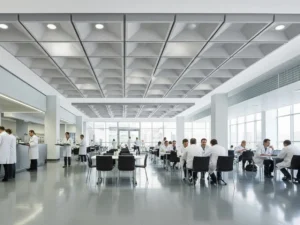
What makes felt-based cladding the architect’s choice for massive surface areas
Large-scale walls in commercial interiors pose a unique design challenge—striking a balance between aesthetics, acoustics, and sustainability. Felt-based green cladding has emerged as the architect’s favored solution for these expansive canvases due to its ability to deliver visual softness, absorb sound, and reflect environmental values in a bold yet subtle way. Unlike traditional finishes like stone or drywall, felt-based systems offer a sensorial richness and performance edge that make them ideal for both new builds and retrofits.
Whether made of organic wool or recycled PET, felt possesses inherent acoustic dampening qualities and can support integrated biophilic components, which are essential in high-traffic, high-reverberation environments. The result is a more human-centric interior experience—visually warm, audibly calm, and operationally flexible.
Felt-based cladding in acoustic excellence
Felt’s fibrous, porous structure makes it a high-performance absorber of sound energy. In spaces with long wall spans—like lobbies, corridors, and open-plan offices—sound often bounces between parallel surfaces, creating excessive reverberation. By specifying felt cladding, architects minimize this reverberation, improving speech intelligibility and reducing noise fatigue. This is especially critical in environments like education, healthcare, and hospitality, where acoustic comfort enhances focus and wellness.
Advanced configurations can push acoustic performance even further. For instance, multi-layer systems combining recycled PET with wool overlay can achieve NRC ratings well above 0.75, providing strategic zoning of silence in active commercial areas. With minimal construction required, felt cladding becomes the smart acoustic upgrade for large surfaces.
Felt-based green cladding for supporting sustainability goals
Green cladding systems today go beyond appearance—they’re crafted with sustainability embedded in the material’s DNA. Wool felt, for example, is a natural, renewable fiber with a long lifecycle and low environmental impact. Recycled PET felt, often derived from plastic bottles, diverts waste from landfills while offering similar acoustic benefits.
When felt-based cladding is paired with preserved or replica greenery, it amplifies biophilic design while maintaining fire code compliance and eliminating the need for live plant maintenance. This integrated approach is especially relevant in urban commercial projects where occupants are disconnected from nature. Architects seeking LEED, WELL, or Living Building Challenge points will find felt-based green cladding a powerful tool in hitting multiple criteria—from low VOC emissions to acoustic performance to psychological wellness.
Screen Leaf Panel, Earth Collection, CSI Creative
Adapting this cladding type adapt to commercial wall-scale applications
Felt-based green cladding is engineered to be flexible—both in form and installation. Designers can specify large-format panels or modular tile systems that conform to flat or curved surfaces. Mounting systems are streamlined for ease of application on drywall, concrete, or metal stud walls. This adaptability is essential in complex commercial spaces such as atriums, lobbies, or even transit terminals, where aesthetics and acoustics must work around architectural irregularities.
Further, felt’s inherent pliability allows seamless integration with lighting, signage, and digital displays. It’s not just a passive surface but a participatory component of modern wall systems, aligning well with experiential branding strategies across sectors.
Can the design potential of felt cladding meet creative brand expression?
Felt cladding excels in more than just function—it’s also a dynamic design medium. Available in hundreds of colors and with custom cutting options like CNC routing, thermoforming, and layering, it allows brand storytelling through shape, color, and texture. This matters in industries like hospitality, corporate, and retail, where every inch of the built environment is leveraged for brand identity.
From bold geometric layouts to lush green wall sculptures, the customization possibilities are practically endless. In workplace environments, companies can specify color schemes that align with their brand palette while also using felt’s acoustic benefits to define collaboration zones or quiet areas. For schools and cultural institutions, the tactile and colorful appeal can turn a wall into a learning or storytelling surface.
How does felt-based cladding compare with other large-scale wall treatments?
Compared to stone, glass, or metal wall systems, felt-based green cladding offers a unique combination of lightness, acoustical absorption, and textural warmth. Hard surfaces tend to reflect sound and require heavy-duty attachment methods, whereas felt systems are lighter, safer, and easier to install, often with pre-fabricated panels that reduce onsite labor.
Aesthetically, felt brings a softer, more welcoming touch—especially in high-occupancy or public-facing environments. While not as physically durable as some hard surfaces, felt offers easy maintenance and replaceability, which can be a strategic advantage in fast-moving commercial spaces.
Metal Lattice, Earth Collection, CSI Creative
The CSI Creative offering in felt-based green cladding
CSI Creative brings these advantages to life with systems like Earth and PoshFelt®, which combine 100% wool or recycled PET felt with lush acoustic greenery. Each wall solution is fire-rated (ASTM E84 Class A), acoustically tuned (NRC ratings customizable per design), and customizable in over 224 felt colors. Greenery tiers range from trimmed moss panels to fully lush foliage systems—all integrated into pre-assembled, spec-ready cladding units.
Recent clients like Fatpour Tap Works have used Earth panels to transform restaurant environments into immersive, sound-controlled oases. These systems are not just décor—they are tools for shaping human experience through material, acoustics, and nature.
Whether designing for corporate headquarters, hotel lobbies, education centers, or wellness clinics, felt-based green cladding from CSI Creative offers architectural performance with emotional intelligence. If you’re ready to bring your next wall to life—functionally and visually—reach out to our team for samples, mockups, and design collaborations tailored to your project site.
Reach out to our sales team to get your next project solved
Our team of experts can help with sample requests, substitutions, ROM takeoffs, product pricing and general consultation.
Upon submitting this form, your CSI point of contact will get back to you in less than 24 hours guaranteed - we are proud to have industry leading response times and project support from contact to install.

















